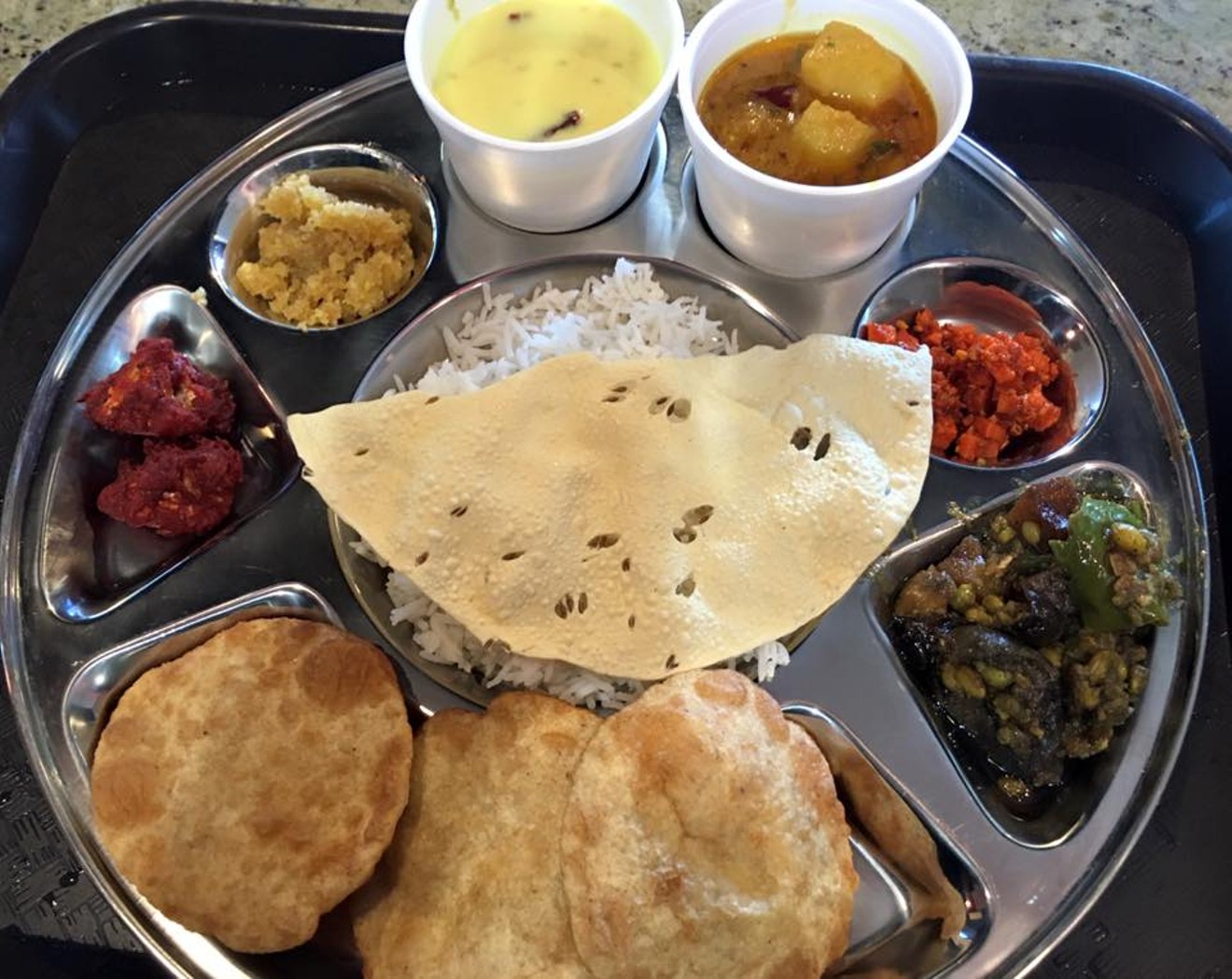How often do you go out to try a new cuisine and end up just scanning the menu for something vaguely familiar? Even the most adventurous eaters could use some pro tips when navigating an unfamiliar menu. To help you order like a native, we put together a series of menu road maps to guide your culinary discoveries throughout metro Phoenix.
Cuisine: Gujarati
Restaurant Name Keywords: Gujarati, Indian
Menu Keywords: Roti, Daal, Bhaat, Shaak
What is Gujarati Food?
As a little girl in my Texas home, I couldn't wait to come home to the sights and smells of my mom cooking the traditional food of Gujarat, an Indian state located on the country's western coastline. Onions, green chilies, and the whispers of garlic perfumed our tiny kitchen while fresh cilantro, cumin, and yogurt my mom made overnight with her special recipe, waited their turns on the counter.
During special occasions, like Diwali or on birthdays, my mom crafted her own Gujarati thali, basically an Indian sampler platter, cooking all day to make certain the meal would be ready in the evening.
She adorned her thalis with roti (homemade fried bread), at least two vegetables, yogurt, rice, daal (lentils), and a savory appetizer like khaman, a spongy, steamed cake made from ground besan (chickpea) flour. I'd sit on the floor, cross-legged and dip my roti in the saucy vegetables and then slurp my daal with hearty satisfaction. We'd cap off this full meal with saffron kulfi (Indian ice cream).
The uninitiated might still be wondering what makes Gujarati cuisine distinct. For one thing, in restaurants, the offerings are almost always vegetarian, with the predominant ingredients revolving around different types of flours, lentils, and vegetables. Gujarati meals rely on a balance of protein and carbs, so they are typically served as a full thali (basically a big sampler platter) containing a roti (bread),a shaak (vegetable) dish, daal, rice, at least one to two appetizers, condiments, and a sweet.
The base for most dishes is a combination of sauteed onion, garlic, green chillies, and tomatoes, to which powdered spices like cumin, coriander, turmeric, and red chili often are added. Fresh cilantro is almost always used as a finishing touch. The resulting flavors are often sweet, salty, and spicy at the same time.
While most Indian food is quantified as "spicy," Gujarati cooking is heavily focused on precise spice blends, which are prepared in such a way that no single flavor takes center stage. Most often, this means a Gujarati dish is likely to have a subtle sweetness as opposed to a burn-your-tongue heat.
If your experience has been limited to the fiery curries and vindaloos of North India, then the cuisine of Gujarat will be a total departure from what you might now think of as "Indian food."
Three great places to start your search for a taste of Gujarati Cuisine are:
Om Bistro, Phoenix
Go for: The complete Gujarati thali meal. The experience is the closest I've found to eating in Gujarat or in a Gujarati's kitchen, right down to the traditional silver platter on which the thali is served.
Namaste Veg Kitchen, Phoenix
Go for: The traditional khadhi soup and savory Gujarati snack, khaman dhokla, along with a glass of nimbu pani, a Gujarati spiced-lemonade, and masala tea, a pan-Indian staple.
Asiana Market, Glendale
Go for: Traditional Indian groceries, such as daals, vegetables, various types of flours, and prepackaged desserts like ras malai (sweet paneer like cheese dipped in milk) and kulfi (Indian ice cream).
Order and Eat Like a Gujarati
Tips: Most Gujarati menus list items in English with a food explanation in parentheses. When ordering, indicate your desired spice level, as the default at many restaurants can be on the spicy side (sometimes spicier than they would serve it in India). It is best to eat your meal with your hands (it really does taste better that way), slurp your condiments right out of their bowls, and burp loudly as way to indicate your satisfaction with the meal (Gujaratis won't mind, though in these parts, you might get some stares from other diners).
STARTERS
Khaman: If I spotted yellow in my mom's kitchen, I knew she was making khaman. A savory steamed cake with a spongy consistency made from ground besan (chickpea) flour. Khaman tastes smooth with subtle hints of salt, chopped ginger, green chili, and turmeric. Khaman's ideal texture isn't grainy or dense, but light and fluffy.
Khandvi: This bite-size savory takes hours to make. As a young girl, I watched my mother work all day to roll out a doughy mixture of gram flour and curds into fragile strips. After drying the strips, they are topped with coriander and coconut. Dipping the soft sticks into a spicy green mint chutney or sweet tamarind chutney completes the experience.
Patra: Colocasia leaves are the staple of this Gujarati appetizer. The dark green leaves are layered with besan flour and infused with cumin, coriander, turmeric, salt, and sugar. The leaves are rolled, steamed, and then sautéed or fried with green chilies, sesame, ginger, and mustard seeds. They are typically topped with grated coconut and can be dipped in a mint or tamarind chutney. It is a specialty of Gujarat that is tangy and sweet simultaneously.
MAINS
Roti (Breads): The base of a Gujarati meal starts with its breads. It is considered an incomplete dinner if some kind of bread isn't present. Breads are either grilled or fried.
Roti is the most common bread in a Gujarati thali. Made using whole-wheat flour, it is toasted on the stove, and after being removed from the heat, it is finished with a good swipe of ghee, a clarified butter.
Bhakhri is a crisp flatbread that is made out of whole-wheat flour and cooked over slow heat. On its own, the bread doesn't have much flavor, but the light saltiness and crunch of the bhakri is a great accompaniment to lentils or curries.
Thepla is an Indian flatbread made from whole-wheat flour and fenugreek leaves that is seasoned with a mixture of coriander, turmeric, and yogurt curds. The resulting bread is similar to a spicy tortilla, and the flavors are enhanced when dipped in yogurt.
Puri is an airy, round of deep-fried bread that is made using whole-wheat flour. In Gujarat, this rich bread is typically reserved for special occasions.
Puran Puri is a sweet stuffed bread that is spiced with nutmeg, saffron, cardamon, and of course, sugar. It makes an excellent complement to spicier side dishes or main dishes.
Shaak (Vegetables): The base of most Gujarati vegetable cooking involves sautéing the trinity of onions, garlic, and hot peppers. Tomatoes can also be added to the dishes, which often include potato curry, stuffed dry bitter gourd, blackened peas in a curry sauce, squash and potatoes, and a dried okra. A thinner consistency is achieved by adding more water or tomato sauce during cooking. The spicing should be mild, as the goal is to taste the natural flavor of the vegetables.
Daal (Lentils): Daals are soups made with lentils. Most contain a blend of sweet, sour, and spicy flavors. As one of the main protein sources for the meal, the variations of daal are plentiful. Toovar daal, also known as yellow pigeon peas, is one of the most widely consumed daals in India. It is brownish in color, and when cooked yields a thin consistency. Toovar daal takes on the flavor of the spices, typically a base of cumin and black mustard seeds, along with fresh green chilies, tomatoes, and ginger mixed in with equal measure. Some households also add yams and peanuts.
Khadhi: This yogurt-based soup is simmered with chickpea flour, and when fully cooked, has a thin consistency and no raw flour taste. Meant to be enjoyed warm, khadhi has a slight sour flavor and can be spicy, depending on how much red chili powder is added. Like most savory soups, you can add ginger, cilantro, or tamarind to enhance the spice, tang, or freshness as desired. A squeeze of lemon adds brightness, while a pinch of sugar helps to balance the heat in the dish.
Bhaat (Rice): My parents often said a Gujarati meal is incomplete without rice. It is typically served warm and eaten at the end of the meal, most commonly, submerged in the daal and topped with raita, a spiced yogurt. There are two other common variations of Gujarati rice, including vagharela bhaat, a stir-fry of day-old rice, oil, onions, hot chilies, and tomatoes, spiced with cumin, coriander, and red chili powder. It is a flavorful Indian version of fried rice, and vegetables are sometimes added. Khichdi, another popular rice dish, is pure comfort food. A simple lentil and rice dish flavored with cumin seeds, turmeric powder, black pepper, ground cloves, green chiles, onions, garlic, and ginger, some choose to add peas and potatoes to make it more nutritious.
CONDIMENTS
Raita: Raita is essential to the meal, especially when a dish is particularly spicy, as the quickest way to cool down the burn is a spoonful of this blend of yogurt, grated carrots, and cucumber, spiced with cumin, mustard seeds, salt, pepper, and red chili powder. Variations of raita abound, with some Gujaratis even adding in cut bananas, Kix cereal, or pomegranate for new twists.
Athanu: The quickest way to increase the heat and spice of Gujarati cuisine is to add athanu to the mix. Athanu is typically a fermented condiment (think kimchi made Gujarati-style) that can be made using hot chili peppers, carrots, mangos, and bird lime fruit (a small, local fruit found in India that is pink-yellow and cooked before eating). You only need tiny spoonful to add a new texture to your meal.
DRINKS
Nimbu Pani: The Gujarati version of lemonade, simple ingredients make this drink a classic, cold refreshment and one that is a traditionally offered to welcome guests to one's home. Water and lemons are the main characters in this chilled beverage, to which black salt, sugar, cumin, chat masala, and mint leaves are added. The best way to enjoy this spicy lemonade is cold, over plenty of ice cubes.
Masala Chai: Every part of India has a version of chai. Gujaratis tend to make their chai spicy, thereby adopting the name "masala" tea. The base involves tea and milk, but depending on your tolerance of heat, you can add varying quantities of grated fresh ginger, coarse black pepper, and powdered cardamom. Gujaratis wake up in the morning with masala chai and may have it as an afternoon drink as well. To drink chai properly, sip or slurp it, but make certain it's scalding hot. Masala chai isn't meant to be enjoyed cold.
Chaash: This salty drink is ideally made with homemade yogurt. The natural flavor of homemade chaash is sweet, but that doesn't mean you can't make it savory. Salt, cumin seeds, grated ginger, diced green chilies, and mustard seeds are often added so that at first sip the drink may seem sour, but as you slurp, it mellows into a complementary blend of flavors.
Learn more about Gujarati Cuisine
To understand the nuances of Gujarati cuisine, it is worth making a few of these items at home. There is an online website called Show Me the Curry that demystifies how to cook Gujarati fare. Food expert Tarla Dalal's cookbook, The Complete Gujarati Cookbook, another great resource. Head to Asiana or Apna Bazaar for the essentials and in no time your kitchen will smell like the streets of Gujarat.
[
{
"name": "Air - MediumRectangle - Inline Content - Mobile Display Size",
"component": "18478561",
"insertPoint": "2",
"requiredCountToDisplay": "2"
},{
"name": "Editor Picks",
"component": "16759093",
"insertPoint": "4",
"requiredCountToDisplay": "1"
},{
"name": "Inline Links",
"component": "17980324",
"insertPoint": "8th",
"startingPoint": 8,
"requiredCountToDisplay": "7",
"maxInsertions": 25
},{
"name": "Air - MediumRectangle - Combo - Inline Content",
"component": "16759092",
"insertPoint": "8th",
"startingPoint": 8,
"requiredCountToDisplay": "7",
"maxInsertions": 25
},{
"name": "Inline Links",
"component": "17980324",
"insertPoint": "8th",
"startingPoint": 12,
"requiredCountToDisplay": "11",
"maxInsertions": 24
},{
"name": "Air - Leaderboard Tower - Combo - Inline Content",
"component": "16759094",
"insertPoint": "8th",
"startingPoint": 12,
"requiredCountToDisplay": "11",
"maxInsertions": 24
}
]














